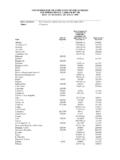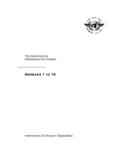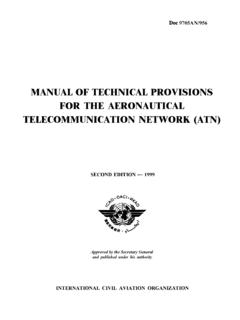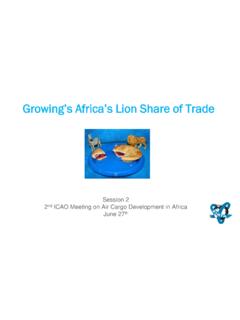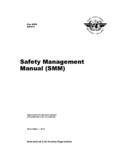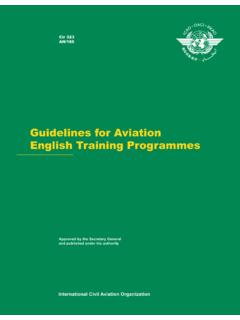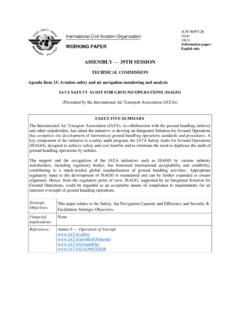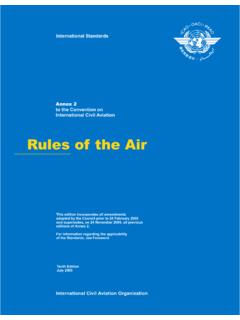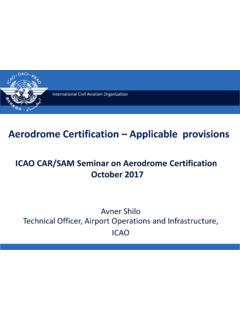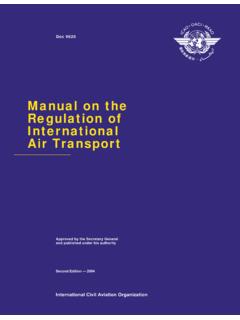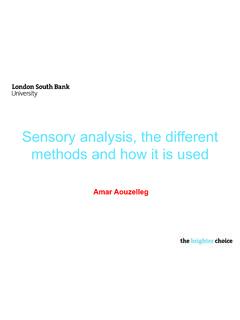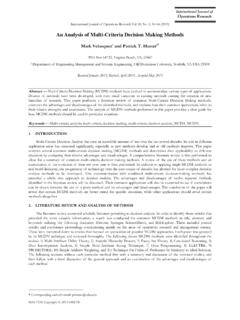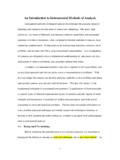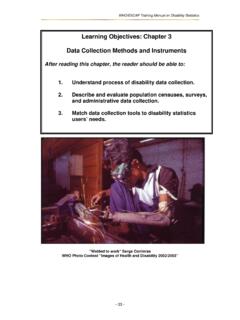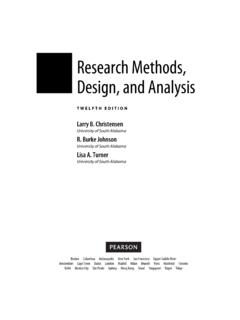Transcription of Data Gathering Methods and Instruments Introduction
1 1 ICAO Training Needs Assessment Data Gathering Methods and Instruments Introduction As discussed on the ICAO TNA website, there are different ways or Methods available to gather data during a TNA. Each one has advantages and disadvantages so that there is no pure method that can do it all . Which to select and use depends on the context of the TNA, the kinds of decisions to make and existing conditions. For example, Methods that take longer to prepare and use aren t efficient when time is short. The key guiding question to ask to select Methods is therefore How can I most effectively and efficiently get the data I need to make good decisions? The 5 most common Methods for data Gathering are, (a) Document reviews (b) Interviews (c) Focus groups (d) Surveys (e) Observation or testing. While each has many possible variations, we will discuss their typical use here.
2 Basic Principles Here are some basic principles to keep in mind when selecting Methods . 1. Consider the characteristics of your target population. A target population is the group of people directly concerned by a TNA. For example, in an organization of 500 people, a TNA may only involve those 50 the target population who are directly affected by a problem. To select Methods for a TNA, review the level of education and employment categories of your target population: (a) The level of education affects the type of questions to ask during an interview or in a survey. Surveys, for example, require being able to read and write to answer. A target population with a lower level of education may not understand a survey and respond improperly. In order to be useful, the Methods selected must be accessible to participants.
3 (b) Employment category also affects how we communicate with the target population. Job level may influence the choice of Methods (using interviews with senior managers and executives, for example) or the language used (different vocabularies for different professions). Other conditions may exist that affect how people react during a TNA. For example, it is often better to interview (sometimes quite informally) disgruntled employees and hear them out than sending 2 ICAO Training Needs Assessment a survey. Interviews help establish more personal rapport that shows attention and interest, and helps get to the bottom of things. 2. Use more than one method. Whenever possible, use more than one method to reach more participants and validate your data. This helps gain a broader or deeper understanding of the problem investigated and triangulate your data.
4 Triangulation happens when different Methods yield similar data. When a needs assessor gets similar answers from different Methods , s/he can feel more confident that the data is complete and valid. As a rule of thumb, use different Methods to gather data until it becomes repetitive (the same or similar data is found) or predictable (it is highly likely that any new data will confirm what is already known). When this happens, you can feel confident of having the data . 3. Consider time, costs, and other constraints. Be real: Methods that can t be used are worthless. Ask yourself how long it will take to write, distribute recover and analyze a questionnaire, for example? Can it be done within the time available? Is it realistic to interview each member of a larger target population located at different work sites? Be real and work with existing conditions, don t give up too easily and conclude something won t work before considering it.
5 Beware of personal preferences for using Methods . Look for options and be open to compromise before deciding about Methods . General Rules The following general rules summarize Table 1 and provide quick reminders of things to consider when selecting Methods . 1. ALWAYS look first for documents that may explain what s happening. Documents sometimes exist that describe a problem well and provide valuable leads about solutions. Review them before deciding about other Methods : what is found in documents can help decide what is missing and how best to get it. 2. Use interviews to interact with senior managers and executives. 3. Use interviews to create more personal rapport. This can be important when working under difficult conditions or when there is significant discord in an organization. 4. Use interviews or focus groups instead of surveys when the level of education is low.
6 5. Use interviews to reach a smaller number of participants, surveys for larger ones. 6. Use focus groups to extend interviews to groups and reach more participants. 3 ICAO Training Needs Assessment 7. User observation or testing when the expected performance is clearly defined in an existing standard. For example, use interviews to explore how change may affect a job, and observation to evaluate job performance. 8. Use Information Communication Technologies (ICT - computers and their networks) to reach a dispersed population. ICT allows distributing surveys to larger (or dispersed) groups, or interviewing participants at a distance. Be sure, however, that everything works well: computer problems (real or perceived) can seriously affect data Gathering and the quality of the answers obtained. 9. Complement your data Gathering using appropriate Methods with informal discussions and observations.
7 Good needs assessors pay close attention to what happens around them and use what they learn. In the end, short, informal conversations about problems at work may be more insightful than the best survey. 10. Avoid becoming fixated with using one method or another. Be flexible and adapt to existing conditions. Keep in mind that the best method is one that works! 4 ICAO Training Needs Assessment Methods Definition Table 1 describes the different Methods that can be used to gather data during a TNA and offers hints on how to use them. Table 1: Summary of Data Gathering Methods and their Use Method Advantages / Disadvantages Comments Surveys / questionnaires Advantages (a) Can reach a large population. (b) Many possible variations in their design and use. (c) Can be completed anonymously. (d) Can be made easy to complete.
8 (e) Can be used to gather quantitative and qualitative data. Disadvantages (a) Can be difficult and time consuming to develop. (b) Influenced by education (reading level) and culture. (c) Can become annoying when not focused or too long. (d) Requires follow up to get a good response rate. (e) Often can t check incomplete or problematic answers. (f) Often ignored when overused. Surveys are often used to collect numerical data. For example, when respondents select numbers on a scale to answer questions. They can also include open questions that require writing an answer. Which to use depends on different conditions, like level of education. Respondents with a limited education may not be able to write longer answers. Interviews can be used to select questions for a survey. After conducting a few of interviews, typical answers or comments are identified and converted into questions for a survey.
9 Example: during some interviews employees indicate that they don t have the tools they needed to perform well. This information could become the following survey question: Select a number on a scale of 1 to 5 that best reflects how you feel about your work tools (1 = Not available; 5 = we have all that we need). Knowledge and skills testing Advantage 1. Relatively easy to prepare when a good job task analysis is available. 2. Focused on job performance. 3. Can take advantage of available subject matter expertise. 4. Results are more easily quantifiable and comparable. Disadvantages 1. Tests are often intimidating or stressful, and can affect performance. 2. Good tests require more work to develop than often expected. 3. Essential knowledge and skills must be clearly reflected to be valid. 4. Can disrupt normal activities.
10 5. Tests measure the ability to perform, not the motivation to do so. Observation or testing are appropriate when there is a clear best way to perform a job, that can be measured specifically (existing standard). For example, when a job requires following the same procedure or applying similar thinking. They can be difficult to use when jobs require adaptive behavior (adjusting performance depending on conditions). Tests must be checked and validated before they are used. This means trying them with some participants, making adjustments and then using them with all other participants. Tests must be short and specific, with only as many questions as needed to assess the whole performance. They must also reflect real job conditions. 5 ICAO Training Needs Assessment Method Advantages / Disadvantages Comments Observation Advantages 1.
